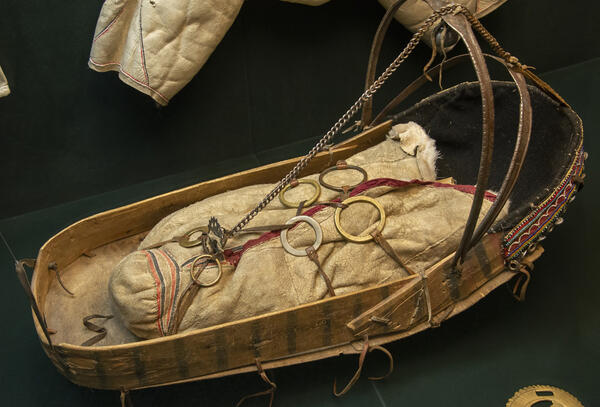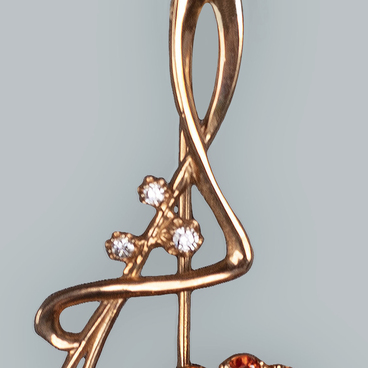In the Nganasan culture, it was the father’s job to make the cradle (lapsa) for his child.
The craftsman used the wood of the local larch tree as the basic material; he made the bottom from plywood, and covered the headboard with a large piece of cloth embroidered with beads on the outside.
To protect the baby from draughts in winter and mosquitoes in summer, the cradle was covered with a cradle canopy fastened on a special arch — kaptysi.
The decoration of cradles was of great importance. The arch was covered with drawings and notches which decorated the cradle, and at the same time served as an original “musical instrument”: the child fell soundly asleep to the shuffling of some metal object on the notches. In addition, copper buttons, plaques, chains, and other shiny and jingling pendants were suspended from the cradle like rattles.
The sides of the cradle were painted with black and red lines on the inside. In the same way, a furry sleeping bag, in which the baby was placed, was painted and embroidered with reindeer hair.
As a hygroscopic material — a “nappy” — the bottom of the cradle was covered with moss or rotten wood chaff, and a layer of deer’s neck hair was placed on top. The moss or chaff was replaced as needed, and the hair was rinsed, dried, and then used again.
The baby was covered with polar fox blankets and tied to the cradle with straps. For feeding, the mother would take the baby together with the cradle, and only take them out to replace the soaked bedding.
The cradle was a multifunctional object: it was a sleeping place hung in the chum, and it was also used as a carrier, convenient for transportation.
When a child grew up, long, closed overalls were sewn from reindeer skin, and minare shoes were attached to them. Girls wore such clothes until they were 12 years old.
Older children also wore a tightly closed kalake, resembling an adult parka, but decorated with simple stripes instead of intricate ornaments. Boys were supposed to wear closed parkas with a hood without fur, while girls wore open ones and the hoods were trimmed with the fur of a black dog.
The craftsman used the wood of the local larch tree as the basic material; he made the bottom from plywood, and covered the headboard with a large piece of cloth embroidered with beads on the outside.
To protect the baby from draughts in winter and mosquitoes in summer, the cradle was covered with a cradle canopy fastened on a special arch — kaptysi.
The decoration of cradles was of great importance. The arch was covered with drawings and notches which decorated the cradle, and at the same time served as an original “musical instrument”: the child fell soundly asleep to the shuffling of some metal object on the notches. In addition, copper buttons, plaques, chains, and other shiny and jingling pendants were suspended from the cradle like rattles.
The sides of the cradle were painted with black and red lines on the inside. In the same way, a furry sleeping bag, in which the baby was placed, was painted and embroidered with reindeer hair.
As a hygroscopic material — a “nappy” — the bottom of the cradle was covered with moss or rotten wood chaff, and a layer of deer’s neck hair was placed on top. The moss or chaff was replaced as needed, and the hair was rinsed, dried, and then used again.
The baby was covered with polar fox blankets and tied to the cradle with straps. For feeding, the mother would take the baby together with the cradle, and only take them out to replace the soaked bedding.
The cradle was a multifunctional object: it was a sleeping place hung in the chum, and it was also used as a carrier, convenient for transportation.
When a child grew up, long, closed overalls were sewn from reindeer skin, and minare shoes were attached to them. Girls wore such clothes until they were 12 years old.
Older children also wore a tightly closed kalake, resembling an adult parka, but decorated with simple stripes instead of intricate ornaments. Boys were supposed to wear closed parkas with a hood without fur, while girls wore open ones and the hoods were trimmed with the fur of a black dog.



